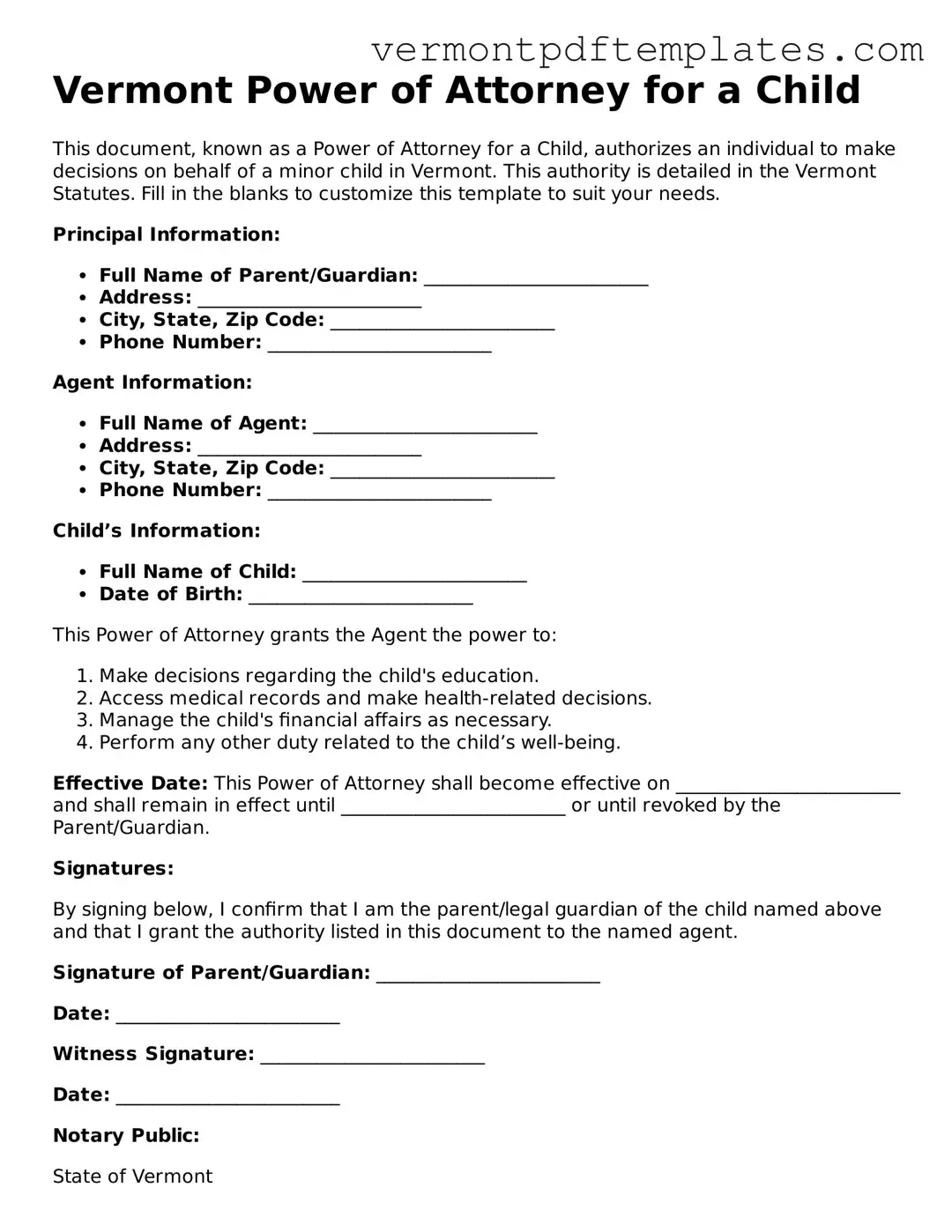The Vermont Power of Attorney for a Child form is similar to a standard Power of Attorney (POA) document, which allows one person to grant authority to another to act on their behalf in various matters. Both documents establish a legal relationship where the appointed individual can make decisions regarding the child's welfare. However, the Vermont form is specifically tailored for the care and custody of minors, ensuring that the appointed agent can make decisions related to education, healthcare, and other child-specific needs.
Another document that shares similarities is the Guardianship Agreement. This legal arrangement grants an individual the authority to care for a child, often in situations where the parents are unable to do so. While a Power of Attorney for a Child is typically temporary and can be revoked, a Guardianship Agreement is generally more permanent and requires court approval. Both documents prioritize the child's best interests and ensure that a responsible adult is designated to make decisions on their behalf.
The Child Custody Agreement is also comparable, as it outlines the arrangements for the care of a child following a separation or divorce. This document specifies which parent has legal and physical custody, similar to how a Power of Attorney for a Child designates a person to act in the child's best interests. Both agreements are designed to provide stability and clarity regarding the child's living situation and decision-making authority.
A Medical Authorization form is another related document. This form grants permission for a designated individual to make medical decisions for a child in the event that the parents are unavailable. Like the Power of Attorney for a Child, it focuses on the child's health and well-being. However, the Medical Authorization form is often limited to healthcare decisions, whereas the Power of Attorney can encompass broader aspects of the child's life.
The Temporary Custody Agreement is similar in that it allows a caregiver to take temporary responsibility for a child, usually in emergency situations. This document provides immediate authority to the caregiver to make decisions for the child until the parents can resume their responsibilities. While the Power of Attorney for a Child can also be temporary, it typically covers a wider range of responsibilities beyond just immediate care.
In situations where a transfer of ownership needs to be documented, it is crucial to have the right forms in place. The California Bill of Sale form, for example, allows sellers and buyers to formally record property transactions. This document acts as a safety net for both parties by providing a clear verification of the sale. For those interested in understanding more about similar legal documents, the Transfer of Ownership Document is another vital resource that aids in ensuring the legitimacy of ownership transfers.
The Adoption Agreement shares some characteristics, as it establishes a legal relationship between a child and their adoptive parents. Both documents are intended to protect the child's welfare and ensure that they are cared for by responsible adults. However, adoption is a permanent legal change in the child's status, while a Power of Attorney is a temporary arrangement that can be revoked by the parents.
A Parenting Plan is another document that is similar in nature. This plan outlines how parents will share responsibilities for their child, including decision-making and time-sharing arrangements. While a Power of Attorney for a Child focuses on appointing someone else to make decisions on behalf of the child, a Parenting Plan is more about collaboration between parents. Both documents are essential in ensuring that the child's needs are met and that they have a stable environment.
Finally, the Child Care Authorization form is relevant. This document permits a caregiver to make decisions regarding a child's care, including enrolling them in school or signing for medical treatment. While it serves a similar purpose to the Power of Attorney for a Child, it is often more limited in scope and duration. Both documents aim to ensure that a responsible adult is available to make necessary decisions for the child's well-being.
